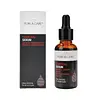What's inside
What's inside
 Key Ingredients
Key Ingredients

 Benefits
Benefits

 Concerns
Concerns

 Ingredients Side-by-side
Ingredients Side-by-side

Water
Skin ConditioningPropanediol
SolventDipropylene Glycol
HumectantCorn Gluten Amino Acids
Skin ConditioningGlycerin
HumectantGlyceryl Glucoside
HumectantSaccharide Isomerate
HumectantCharcoal Powder
AbrasiveSodium Hyaluronate
HumectantMelaleuca Alternifolia Leaf Oil
AntioxidantScutellaria Baicalensis Root Extract
AstringentHouttuynia Cordata Extract
Skin ConditioningPortulaca Oleracea Extract
Skin ConditioningOpuntia Ficus-Indica Extract
Skin ConditioningPaeonia Suffruticosa Root Extract
Skin ProtectingChrysanthemum Indicum Flower Extract
Skin ConditioningAllantoin
Skin ConditioningPanthenol
Skin ConditioningTocopheryl Acetate
AntioxidantLactic Acid
BufferingArginine
MaskingCitric Acid
BufferingSodium Citrate
Buffering1,2-Hexanediol
Skin ConditioningHexylene Glycol
EmulsifyingXanthan Gum
EmulsifyingHydroxyacetophenone
AntioxidantSodium Hydroxide
BufferingLimonene
PerfumingWater, Propanediol, Dipropylene Glycol, Corn Gluten Amino Acids, Glycerin, Glyceryl Glucoside, Saccharide Isomerate, Charcoal Powder, Sodium Hyaluronate, Melaleuca Alternifolia Leaf Oil, Scutellaria Baicalensis Root Extract, Houttuynia Cordata Extract, Portulaca Oleracea Extract, Opuntia Ficus-Indica Extract, Paeonia Suffruticosa Root Extract, Chrysanthemum Indicum Flower Extract, Allantoin, Panthenol, Tocopheryl Acetate, Lactic Acid, Arginine, Citric Acid, Sodium Citrate, 1,2-Hexanediol, Hexylene Glycol, Xanthan Gum, Hydroxyacetophenone, Sodium Hydroxide, Limonene
Aloe Barbadensis Leaf Water
MaskingDiethylhexyl Succinate
EmollientPropanediol
SolventWater
Skin ConditioningDrometrizole Trisiloxane
UV AbsorberEthylhexyl Triazone
UV AbsorberNiacinamide
SmoothingDiethylamino Hydroxybenzoyl Hexyl Benzoate
UV FilterTerephthalylidene Dicamphor Sulfonic Acid
UV Absorber1,2-Hexanediol
Skin ConditioningBehenyl Alcohol
EmollientMethyl Trimethicone
Skin ConditioningSodium Polyacryloyldimethyl Taurate
Emulsion StabilisingHamamelis Virginiana Leaf Water
AstringentTromethamine
BufferingPolyacrylate Crosspolymer-6
Emulsion StabilisingArachidyl Alcohol
EmollientCaprylyl Glycol
EmollientEthylhexylglycerin
Skin ConditioningArachidyl Glucoside
EmulsifyingSodium Metaphosphate
BufferingAdenosine
Skin ConditioningTocopherol
AntioxidantSodium Hyaluronate
HumectantAllantoin
Skin ConditioningCitric Acid
BufferingSodium Benzoate
MaskingPotassium Sorbate
PreservativeAloe Barbadensis Leaf Water, Diethylhexyl Succinate, Propanediol, Water, Drometrizole Trisiloxane, Ethylhexyl Triazone, Niacinamide, Diethylamino Hydroxybenzoyl Hexyl Benzoate, Terephthalylidene Dicamphor Sulfonic Acid, 1,2-Hexanediol, Behenyl Alcohol, Methyl Trimethicone, Sodium Polyacryloyldimethyl Taurate, Hamamelis Virginiana Leaf Water, Tromethamine, Polyacrylate Crosspolymer-6, Arachidyl Alcohol, Caprylyl Glycol, Ethylhexylglycerin, Arachidyl Glucoside, Sodium Metaphosphate, Adenosine, Tocopherol, Sodium Hyaluronate, Allantoin, Citric Acid, Sodium Benzoate, Potassium Sorbate
 Reviews
Reviews

Ingredients Explained
These ingredients are found in both products.
Ingredients higher up in an ingredient list are typically present in a larger amount.
1,2-Hexanediol is a synthetic liquid and another multi-functional powerhouse.
It is a:
- Humectant, drawing moisture into the skin
- Emollient, helping to soften skin
- Solvent, dispersing and stabilizing formulas
- Preservative booster, enhancing the antimicrobial activity of other preservatives
Allantoin is a soothing ingredient known for its protective and moisturizingg properties. Because of this, it is often added to products with strong active ingredients.
Studies show higher concentrations of this ingredient can promote wound healing.
Though it can be derived from the comfrey plant, allantoin is produced synthetically for cosmetic products to ensure purity.
Learn more about AllantoinCitric Acid is an alpha hydroxy acid (AHA) naturally found in citrus fruits like oranges, lemons, and limes.
Like other AHAs, citric acid can exfoliate skin by breaking down the bonds that hold dead skin cells together. This helps reveal smoother and brighter skin underneath.
However, this exfoliating effect only happens at high concentrations (20%) which can be hard to find in cosmetic products.
Due to this, citric acid is usually included in small amounts as a pH adjuster. This helps keep products slightly more acidic and compatible with skin's natural pH.
In skincare formulas, citric acid can:
While it can provide some skin benefits, research shows lactic acid and glycolic acid are generally more effective and less irritating exfoliants.
Most citric acid used in skincare today is made by fermenting sugars (usually from molasses). This synthetic version is identical to the natural citrus form but easier to stabilize and use in formulations.
Read more about some other popular AHA's here:
Learn more about Citric AcidPropanediol is an all-star ingredient. It softens, hydrates, and smooths the skin.
It’s often used to:
Propanediol is not likely to cause sensitivity and considered safe to use. It is derived from corn or petroleum with a clear color and no scent.
Learn more about PropanediolSodium Hyaluronate is hyaluronic acid's salt form. It is commonly derived from the sodium salt of hyaluronic acid.
Like hyaluronic acid, it is great at holding water and acts as a humectant. This makes it a great skin hydrating ingredient.
Sodium Hyaluronate is naturally occurring in our bodies and is mostly found in eye fluid and joints.
These are some other common types of Hyaluronic Acid:
Learn more about Sodium HyaluronateWater. It's the most common cosmetic ingredient of all. You'll usually see it at the top of ingredient lists, meaning that it makes up the largest part of the product.
So why is it so popular? Water most often acts as a solvent - this means that it helps dissolve other ingredients into the formulation.
You'll also recognize water as that liquid we all need to stay alive. If you see this, drink a glass of water. Stay hydrated!
Learn more about Water